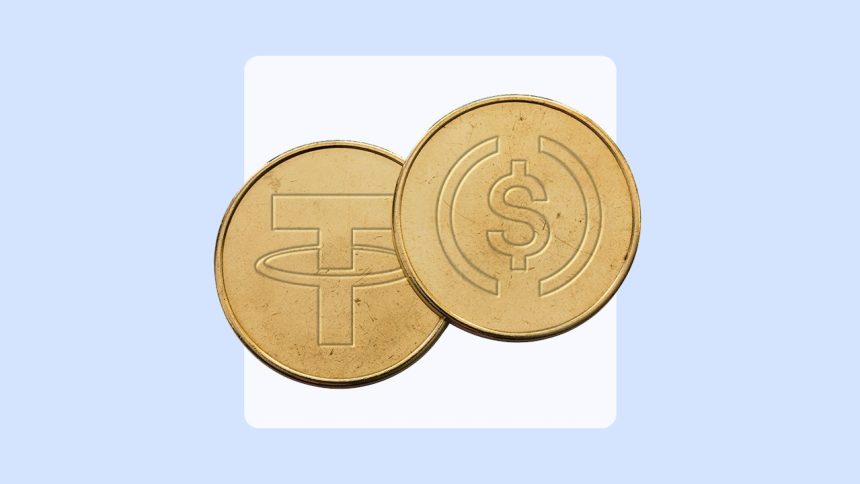Images by Getty Images; Illustration by Bankrate
Stablecoins are a type of cryptocurrency specifically designed to maintain their price over time, usually by being pegged to the U.S. dollar. Tether (USDT) and USD Coin (USDC) are just two of the most popular types of stablecoins, but they vary in a few key ways.
Here’s a look at how the two cryptos stack up and what you need to know before investing.
USDT vs. USDC: How these stablecoins stack up
These two coins might sound similar — they’re both stablecoins and begin with the same first three letters — but they have some key differences to pay attention to, including the way they allocate their reserves and their approach to transparency.
Here’s a quick side-by-side that shows how they differ. Data is from CoinMarketCap.com as of June 3, 2025.
| Key facts | Tether | USD Coin |
|---|---|---|
| Symbol | USDT | USDC |
| Year created | 2014 | 2018 |
| Market cap | $153.4 billion | $61.1 billion |
| Blockchain | Multiple | Ethereum and others |
| Ownership | Private | Going public |
| Audit cycle | Quarterly | Monthly |
Tether
Created in 2014, USDT is a fiat-backed stablecoin, meaning each token is backed by $1 or cash equivalent. USDT is widely accepted and used across many different types of blockchains.
Reserves
The cash that backs the tokens is held in the form of reserves and is managed by Tether Holdings Limited (USDT’s private, parent company). According to its most recent reserve report on March 31, Tether reported more assets than liabilities, with $149.3 billion in reserves and about $143.7 billion in circulating coins.
Tether’s got quite the breakdown of reserves. The majority are in U.S. Treasury bills ($98.5 billion, to be exact), overnight repurchase agreements, term reverse repurchase agreements, money market funds, cash/bank deposits and other non-Treasury bills. But Tether also has some alternative asset allocations, including secured loans, Bitcoin, precious metals and corporate bonds.
Use cases
Many investors use USDT tokens as a way to park their gains after selling their crypto so that they don’t have to completely cash out of a crypto exchange. This avoids on- and off-ramp fees, which are fees charged when you move your fiat money in and out of a crypto account.
Transparency
The token has previously faced some criticism surrounding its transparency and backing, as well as market manipulation accusations, with some experts even claiming that Tether has been used to drive up the price of Bitcoin.
USDC
USDC was created in 2018 and is also backed by the U.S. dollar. It’s managed by a company called Circle and runs on the Ethereum blockchain, and is compatible with other blockchains, including Algorand, Stellar, Binance Smart Chain and Hedera, to name a few.
Circle is in the process of becoming a publicly traded company, with crypto exchange Coinbase holding an equity stake. Circle and Coinbase were key players in the consortium that founded USDC.
Reserves
Unlike Tether’s quarterly reports, Circle reports its full reserves monthly, though each week it discloses reserve assets, minting and redemption (Tether issues updates on their tokens in circulation daily). As of June 2, 2025, there were $61 billion USDC coins in circulation and $61.3 billion in reserves, according to Circle.
The USDC reserve is made up of almost 90 percent short-term U.S. Treasurys and overnight repurchase agreements, according to Circle’s “2025 State of the USDC Economy” report. The remainder is in cash or cash equivalents.
Use cases
USDC offers some of the same benefits that Tether does. For example, USDC acts as a store of value and gives investors a place to park their cash instead of cashing out of crypto altogether.
Transparency
The real difference between the two tokens lies in the history of transparency both companies have shown. USDC has generally provided more transparency regarding its reserves than Tether has.
What you should know before buying USDT or USDC
It’s important to understand that though these coins are designed to experience fewer fluctuations in price, you’re still investing in a type of crypto, and crypto itself is extremely speculative.
And there are a few other drawbacks to keep in mind:
- No cash-generating returns: Cryptocurrencies — in this case, stablecoins — don’t have the potential for capital gains like a stock would. If you don’t regularly trade crypto, your money might be better served by investing in crypto ETFs or individual stocks rather than parking your cash.
- Not FDIC-backed: USDC and USDT may be backed by cash, but that cash held in reserves isn’t insured by the FDIC. Normally, the FDIC protects individual depositors by up to $250,000 per account in the event of a bank failure, but this doesn’t apply to stablecoins.
- De-pegging risk: Sure, stablecoins see less fluctuation in price, but they are at a broader risk of losing basically their entire value for several reasons, an event known as de-pegging. This can happen for a few reasons, including a major lack of liquidity, regulatory changes or market declines.
Bottom line
Stablecoins like USDT and USDC have eliminated some common challenges crypto investors face, like where to put your money if you don’t want to completely cash out of a crypto exchange. However, each coin is different and stablecoins come with some drawbacks to consider before investing.
Editorial Disclaimer: All investors are advised to conduct their own independent research into investment strategies before making an investment decision. In addition, investors are advised that past investment product performance is no guarantee of future price appreciation.
Read the full article here














